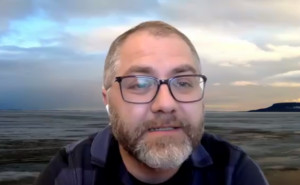Anishinabek Nation hosts virtual E’Dbendaagzijig conference

By Rick Garrick
ANISHINABEK NATION TERRITORY — Fort William First Nation’s Damien Lee highlighted his adoption as an infant by the MacLaurin family during his Citizenship through the Lens of Adoption presentation at the Anishinabek Nation E’Dbendaagzijig (Citizenship) Virtual Conference on April 28.
“I was adopted through Anishinaabe law, not provincial law,” says Lee, assistant professor and Canada Research Chair in Biskaabiiyang and Indigenous Political Resurgence at Toronto Metropolitan University. “Anishinaabe law … still exists and we know this. I belong with Anishinabek because of Anishinaabe law. So that is a really important thing to highlight here, not only in introducing myself but to reflect back to the vitality of Anishinaabe nationhood despite hundreds of years of violent colonialism.”
Lee says he is not a Status Indian, but he is a citizen of Fort William, noting that Fort William has a membership code that allows for non-Status individuals to become citizens through adoption.
“As a physical body, I am a [non-Indigenous] person but I was raised Nish, I was raised on the rez,” Lee says. “The way racism works in our society, I am treated differently than my dad and my brother and my sister, so I am not saying that all of my experiences are the same as everybody in this room for example, but when we talk about citizenship in politics, I like to think about it as a line or a circle around the nation. If there is a line drawn by citizenship law, I’m very clearly on the Nish side of the line because of all the things I’ve just mentioned and a bunch of things I can’t get to today. I renew my belonging every year through carrying my responsibilities and doing what I’m supposed to do.”
Lee also highlighted how adoption was seen as dangerous by a stipendiary magistrate in 1895, but as an expression of kinship by the Anishinabek.
“He (E.B. Borron) goes on to say if the First Nations adopt Tom, Dick, and Harry and if these adoptees can claim the treaty annuities, this will impose a heavy and unjust burden on the Crown — adoption as citizenship-making should be modified if possible,” Lee says, paraphrasing the magistrate’s comments. “Nish at this time in Robinson Huron and Superior are claiming those people that they know belong through kinship. So the colonialists … target adoption as one of the things that needs to be seen as dangerous, and so therefore, removed. Why? Because it’s an expression of nationhood, it goes against the thinking of the time that Indians are a biological race that are dying out.”
Caroline Brown, an Emmy-award-winning artist and Teme-Augama Anishnabai citizen, highlighted her family’s path to regaining citizenship, including her cousin Peter Brown McMillan’s application for Indian Status in 1993, which was rejected 15 months later, during her A Family Divided by the Indian Act presentation at the E’Dbendaagzijig Conference.
“The rejection letter was a blow that resulted in so much frustration that cousin Peter couldn’t look at these papers anymore and it would be years before he could deal with it again,” Brown says. “By 2010, I had committed to putting all our family info together — I began to research and verify our genealogy and I was inspired by the discrimination of the Indian Act— I was inspired by Peter’s rejection.”
Brown says she sent in her application for Indian Status in 2012 along with a copy of her family book that includes family documents and official government records.
“We wanted to ensure INAC (Indigenous and Northern Affairs Canada) would have all the answers to any questions right there in their hands,” Brown says. “Two years later after submitting my application, I received a letter from INAC requesting the letters I’d already sent. So, I resubmitted the requested records. One year later, I received a letter that I was registered for Indian Status. Three months later, my brother Harry was registered, six months later, my brother Peter was registered.”
Brown says her cousin Peter then submitted another application for Indian Status along with another family book, and he was registered 19 months later, 27 years after his original application.
The conference also featured comments by Anishinabek Nation Grand Council Chief Reg Niganobe; Patrick Madahbee, Anishinabek Nation Commissioner on Governance; Mary Laronde, Anishinabek Nation Restoration of Jurisdiction Department policy analyst; Leanna Farr, Anishinabek Nation legal counsel; Cherie Mercer, Nisga’a Lisims Government citizenship registry manager/programs and services; Fred Bellefeuille, Anishinabek Nation legal counsel; and Jeannette Corbiere Lavell, Anishinabek Nation Citizenship Commissioner.


